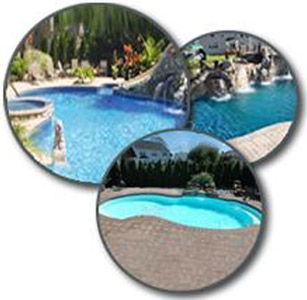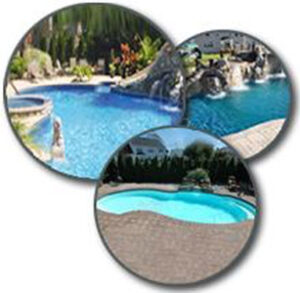What Are the Different Types Of Inground Swimming Pool Construction?

You have been thinking about installing an inground pool, but you just found out that there are different types of pools. So what are the types and which one would be best for you? Well the answer really depends on what you want in a pool and what is most important to you.

SO WHAT ARE THE TYPES OF POOLS I CAN BUILD?
There are three different categories of inground swimming pools. They are vinyl liner inground pools, fiberglass inground pools, and concrete inground pools. Each inground swimming pool is classified by the material that they are constructed out of, each of which have various pros and cons. Depending on what you
want and what your budget is, will ultimately dictate what type of pool to get.
LET’S TALK ABOUT VINYL LINER POOLS…
In the northeast, the vinyl liner inground pools is amongst the most popular. There are three different varieties of vinyl liner pools. One is the steel wall vinyl liner, which is most commonly made with galvanized or stainless steel panels. The next is the polymer/composite wall vinyl liner pool. The last type is the cement wall vinyl liner pool. Out of all the vinyl liner pools, the most popular are the steel wall and cement wall pools. The biggest advantage to these types of pools is that you can do just about any shape or style with these two materials. This is because steel is structurally sound and can be cut and molded into any size, shape, dimension, look, or feel. Just about anything a future pool owner is looking for can be created. The same can be said for the cement vinyl liner pools. After that, a liner can be cut to fit any shape or size pool. The biggest downfall of the steel wall vinyl liner walled pool is it can eventually corrode and oxidize. It is generally not the pool to get if you live in an area with a high water table or an area that is not for soil that holds water. The polymer/composite pool is more limited due to the pinning or locking system used to assemble the panels. This gives a bit more restriction in terms of how structurally sound they are although as a result of its material make up it has a long lifespan compared to a steel wall vinyl pool.
I HEARD FIBERGLASS POOLS ARE THE BEST! IS THAT TRUE?
If you are like many you may have run across this line and no, fiberglass pools are not the best. A fiberglass pool is a one piece. They are built in a controlled environment inside a factory and then shipped over the road to the buyer’s house. You may have seen a pool being carried along the roadside and then sent over to the end user. First a precise hole is dug and then (at least in theory) the pool is carefully lifted and placed into the ground. As previously stated every fiberglass pool is one piece and comes standard with built in benches, love seats and in some cases sun decks. The biggest benefit of owning a fiberglass pool is that it is a quicker installation than the other types of pools. They typically have very low long term maintenance costs. They are at the middle of the road price point wise, although they are often thought of as the most inexpensive of all pool types from a consumer’s standpoint. This means they are not as expensive as a concrete pool, but they cost more than their vinyl liner counterparts. Their biggest drawbacks are size and shape. They can’t be customized and generally do not come in many varieties. They generally can’t be used as diving pools, and they can’t be “T” or “L” shaped because of their need to be transported as one piece. Colors are also somewhat limited for their interiors; most manufacturers only offer two to six colors.
FINALLY THERE ARE CONCRETE POOLS
The final type of pool is the concrete pools. Sometimes they are commonly referred to as gunite or shotcrete pools. The difference between the two is how the concrete is mixed and applied to the pool. To learn more about gunite versus shotcrete please see the Seasonal World Blog that talks about the difference between gunite and shotcrete pools. There are almost no limitations with a concrete pool. They are thought of as the higher end type pools. They have an interior finish that can be a white plaster or marcite, or a colored plaster. They can have pebble finishes, quartz finishes, all the way up to smooth glass bead finishes. This creates a very unique looking product. Concrete pools may come with porcelain, ceramic, or glass tile bands around the entire pool. They are also unique in that they can be constructed with negative edges, perimeter overflows, as well as benches and bars built right into them.
HOW ARE THEY CONSTRUCTED?
First, a hole is precisely excavated, all plumbing work is installed, and then a complete interlocking cage of rebar is erected. After rebar reinforcement is in place, the concrete is applied, set, and left in place a minimum of twenty eight to thirty days for curing. During the course of this period the coping and surrounding deck are completed. Then the interior tile work is set into place. Finally after the concrete has cured, the interior finish is applied. At this time the pool is immediately filled with water and filtration system started. Concrete pools tend to be the strongest of all the inground swimming pools. Since they are rebar and concrete they can’t oxidize or corrode. Like every other form of concrete, they get stronger as time passes. They are at the upper echelon of price points and have a higher end product reputation.
WHAT ARE THE POOL PRICE POINTS?
Vinyl liners are usually the most economical of all the different types of pools. Quality fiberglass pools typically fall in the middle. Concrete (gunite/shotcrete) because of the material costs as well as the amount of labor, is generally the most expensive of the three. This is contingent on the individual market which varies by area of the country and what is referenced above is based on the Northeast pool market.
OK, SO WHAT POOL SHOULD I GET?
Each type of pool has its own pros and cons. The choice of what type of pool to get is contingent on what the prospective buyer finds is the most important. At the end of the day, what you want the finished product to look like, and what you want to spend in terms of project total will dictate what type of pool you choose to get. All in all, an inground pool no matter what type will provide a platform of family fun for a lifetime!
